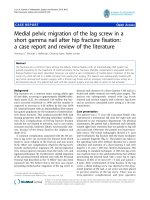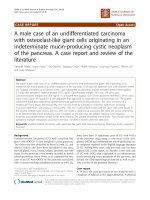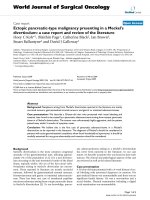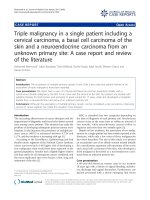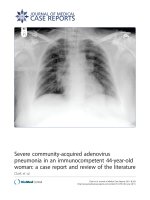Leukemoid reaction in cervical cancer: A case report and review of the literature
Bạn đang xem bản rút gọn của tài liệu. Xem và tải ngay bản đầy đủ của tài liệu tại đây (1.59 MB, 8 trang )
Qing et al. BMC Cancer 2014, 14:670
/>
CASE REPORT
Open Access
Leukemoid reaction in cervical cancer: a case
report and review of the literature
Li Qing1, Tao Xiang2, Zhang Guofu3 and Feng Weiwei1,4*
Abstract
Background: The presentation of a leukemoid reaction in cervical cancers is rare. A leukemoid reaction is defined
as leukocytosis associated with a cause outside the bone marrow, with the white blood cell count (WBC) exceeding
50*109/L. Two cervical cancers presenting with leukemoid reactions were previously reported. However, the cancers
in these cases were mainly in the advanced stages and had a poor outcome.
Case presentation: Here we report a 40-year old patient with clinical stage (FIGO IIA1) cervical squamous carcinoma
suffering from vaginal cuff recurrence with a leukemoid reaction two months after laparoscopic radical hysterectomy.
The patient suffered from persistent fever and leukocytosis after one month of antibiotic treatment accompanied by
rapid growth of the vaginal mass indicated that the leukocytosis could not be caused only by infection. After paclitaxel
injection, the WBC count increased to 70.37*109/L. Bone marrow aspirates and biopsy showed left-shift neutrophilia,
which confirmed leukemoid reaction. After two courses of paclitaxel and cisplatin treatment, the white blood cell
counts decreased to normal, the fever disappeared, and the vaginal mass was reduced dramatically. She achieved
completed remission after subsequent chemo-radiation and two additional courses of chemotherapy.
Conclusion: In our case, leukemoid reaction was related to recurrent cervical carcinoma and sensitive to chemotherapy.
To our knowledge, this is the third case to be reported in the literature. Furthermore, this is the only case described that
shows an unequivocal correlation between tumor response and leukemoid reaction.
Keywords: Leukemoid reaction, Cervical cancer
Background
Cervical cancer is the third most common cancer and
the fourth leading cause of cancer death in women
worldwide, and more than 85% of cases occur in developing countries [1]. Clinically, the primary treatment for
early stage cervical cancer is surgery, radiation therapy,
or concurrent chemoradiation. The 5-year survival rate
for early stage cervical cancer is 70% [2].
A white blood cell count (WBC) exceeding 50*109/L
associated with a cause outside the bone marrow is
termed a leukemoid reaction (LR). LR is generally benign, although it could resemble more serious conditions
that are medical dilemmas. Its frequency in patients with
nonhematologic cancers remains unclear, although it has
* Correspondence:
1
Department of Gynecology, Obstetrics and Gynecology Hospital, Fudan
University, Shen Yang Road 128, Shanghai, China
4
Shanghai Key Laboratory of Female Reproductive Endocrine-Related Disease,
Fudan University, Shanghai, China
Full list of author information is available at the end of the article
been reported to range from 1% to 4% in small case series.
LR has been reported in nearly all solid tumor types as a
paraneoplastic syndrome and is historically associated
with poor outcome. Cervical cancers presenting with LR
are rarely reported. Only two authors, Nimieri [3] and Kyo
[4], have reported LR in cervical cancer patients. However,
the cancers in these cases were mainly in advanced stage.
Here, we report a patient with relatively early stage (International Federation of Gynecology and Obstetrics, FIGO
IIA1) cervical squamous carcinoma suffering from recurrence with LR two months after laparoscopic radical hysterectomy. The clinical and histological features are
described. The literature describing these rare cases is also
reviewed.
Case presentation
Case report
A 40-year-old woman who was experiencing increased
discharge and postcoital bleeding for 2 months was
admitted to the Obstetrics and Gynecology Hospital of
© 2014 Qing et al.; licensee BioMed Central Ltd. This is an Open Access article distributed under the terms of the Creative
Commons Attribution License ( which permits unrestricted use, distribution, and
reproduction in any medium, provided the original work is properly credited. The Creative Commons Public Domain
Dedication waiver ( applies to the data made available in this article,
unless otherwise stated.
Qing et al. BMC Cancer 2014, 14:670
/>
Fudan University on April 18, 2012. A 3.5 cm cervical
stump was found via bimanual examination, and tissue
biopsy results verified that it was infiltrative cervical
squamous carcinoma. Magnetic resonance imaging
(MRI) examination indicated a 2.7*2.2*3.4 cm lesion in
the posterior cervix, accompanied by disappearance of
the posterior fornix. (Figure 1A) Preoperative examinations, including a routine blood test (WBC: 5.93*109/L,
neutrophils: 58%, lymphocytes: 33%, monocytes: 6%, eosinophils: 2%), analysis of tumor markers (squamous cell
cancer antigen, SCCA: 0.7 ng/mL; CA125: 14.32 U/L), and
determination of the leukocyte alkaline phosphate score
(LAP: 145 U/L), produced normal results (Figure 2). Because the patient was diagnosed with Federation of Gynaecology and Obstetrics (FIGO) IIA1 cervical cancer, she
underwent surgery (laparoscopic radical hysterectomy,
pelvic lymphadenectomy, vaginoplasty, and ovarian transposition) on April 24, 2012. A pathological examination
revealed a 3 cm non-keratinized squamous carcinoma located in 3°-9° of the cervix, with distances of 1.5 cm up to
internal orifice and 0.5 cm down to the fornix. The tumor
was confined to the inner half of the cervical stroma; lymphovascular invasion and pelvic lymph node metastasis
were not detected. Immunohistochemical staining showed
positivity for p16 (+++), p53 (+), and Ki-67 (90%+), and
CD31 and D240 staining confirmed that the vessels were
intact (Figure 3). Because the patient had no risk factors
for adjuvant therapy, she was dismissed from the hospital
7 days after the operation.
On July 2, 2012 (68 days after the operation), she presented to the outpatient clinic with increasing discharge.
A 2*3 cm swollen cystic area was found in the posterior
vagina. As purulent cells were found in her vaginal discharge, she was diagnosed with vaginitis and prescribed
Page 2 of 8
ornidazole to control the infection. On July 16, 2012,
due to a high fever of 39.2°C and urine retention, she
went to the urological outpatient clinic to receive
catheterization. With a white blood cell count of 23*109/L,
she was diagnosed with a urinary tract infection and received intravenous cefotiam and levofloxacin. However,
her fever was not well controlled. On July 30, 2012,
a 60 mm diameter solid mass on the posterior vagina
with an ulcerous surface was found by gynecological
examination. MRI scan confirmed a homogeneous solid
68*63*58 mm mass located in the space between the
bladder and the rectum (Figures 1B and 4). MRI well
displayed the tumor itself and its margin. After injection
of contrast materials, the relationship between the
tumor and surrounding tissues also was well appreciated on serial MRI scans. Hydronephrosis of both kidneys and distension of upper region of the left ureter
were confirmed by ultrasonic inspection. Biopsy was
performed on the mass, which demonstrated degenerated squamous cells within necrotic tissue.
She was admitted to the inpatient ward again on August 2.
2012. Because of an uncontrollable fever (range: 39–40.5°C)
and leukocytosis (WBC: 29.66*109/L), samples of her
blood, urine, and vaginal discharge were taken for bacterial culture to identify the source of infection. The cultures
were all negative on August 2, 2012; however, Escherichia
Colli, ESBLs (extended-spectrum β-Lactamase) sensitive
to tienam and amikacin were found in a vaginal bacterial
culture on August 5, 2012. Repeated discharge culture on
August 12, 2012 was negative and became ESBLs positive
again on August 17, 2012, then turned to negative on
August 29, 2012. Since admission, empiric therapy with
ceftriaxone sodium and metronidazole had been used;
however, this was subsequently changed to a combination
Figure 1 Magnetic resonance imaging of primary and recurrent cervical mass. A. The arrow indicated a 2.7*2.2*3.4 cm lesion in the posterior
cervix, accompanied by disappearance of the posterior fornix. B. The arrow indicated a 68*63*58 mm mass in the vaginal cuff.
Qing et al. BMC Cancer 2014, 14:670
/>
Page 3 of 8
Figure 2 Dynamic changes in tumor volume (the maximum diameter of tumor), tumor markers (SCCA and CA125), white blood cell
(WBC) counts, and LAP response to chemotherapy. Upper panel: The levels of CA125 and SCCA were correlated with the tumor volume.
The WBC counts remained at a high level since recurrence and reached its highest value after the first round of chemotherapy. Bottom panel:
The levels of LAP, neutrophils, lymphocytes, and monocytes were in accordance with the WBC counts.
Figure 3 HE and immunohistochemical (Ki-67, CD31, P53) staining of primary (A, B, C, D) and relapsed (E, F, G, H) cancer tissues.
H&E staining (A) showed irregular nests of squamous cell carcinoma dispersed in the stroma, with various quantities of inflammatory cells
infiltrating the stromal tissues as well as cancerous nests. In the relapsed cancer tissue (E), neutrophils were more predominant, whereas in
primary cancer tissues, a mixed population of lymphocytes and neutrophils was observed. The immunohistochemical staining patterns of Ki-67
(B, F), CD31 (C, G), and p53 (D, H) were similar in the primary and relapsed tissue. Ki-67 positively expressed in >90% of tumor cells. P53 was
strongly expressed in tumor cells.
Qing et al. BMC Cancer 2014, 14:670
/>
of tienam and vancomycin according to a drug sensitivity
test on Aug 5, 2012. From August 12, 2012 to August 24,
2012, the patient was treated with norvancomycin and
cefoperazone-sulbactam and subsequently with piperacillintazobactam plus amikacin for an additional 7 days.
On the other hand, although a biopsy on July 30, 2012
showed no malignancy (the possible negative result
might be attributed to superficial biopsy sample), the recurrence of cervical carcinoma was highly suspected because the vaginal mass increased from 22*33*22 mm on
July 2, 2012 to 63*65*58 mm on July 30, 2012 and the
characteristics showed by MRI highly suggested a recurrent tumor. The tumor mass increased to 80 mm in
diameter by palpation on August 6, 2012. A second
bulky biopsy was performed on August 7, 2012. In order
to get enough tissue, we cut the surface open, and excised a 60*40*20 mm mass. The whole mass was solid
without abscess. After the biopsy, the tumor volume
shrank to 70*40*40 mm. Pathology examination confirmed recurrent squamous carcinoma. Immunochemistry staining for Ki-67 and P53 was also performed
(Figure 3). Chemotherapy was considered but was postponed because the patient was recently given sensitive antibiotics (tienam and vancomycin) and effective control of
fever and leukocytosis was expected. However, one week
later, the high fever (up to 39.2°C) and leukocytosis (up to
33.4*109/L) were persistent. In addition, the mass continued growing to 90*82*74 mm on August 14, 2012 and
tumor makers became abnormal (CA125: 76.66 U/L,
SCCA: 5.3 ng/ml). Considering the severity of the situation, we decided to give the patient a new regimen of antibiotics and chemotherapy simultaneously.
Regarding chemotherapy, paclitaxel (200 mg) was administered intravenously on August 15, 2012. Unexpectedly, on the following day, her fever increased (40.3°C),
and the planned cisplatin treatment was cancelled. On
August 21, 2012, cisplatin (100 mg) was injected because
the patient had become relatively stable (fever, 39°C;
WBC, 18.95*109/L). On August 25, 2012, her WBC count
reached 70.37*109/L, and a leukemoid reaction (LR) was
suspected. Bone marrow aspirates and biopsy showed an
increased myeloid/erythroid ratio, active myeloid proliferation, and normal megakaryocytopoiesis. Meanwhile, her
LAP level was extremely high (869 U/L). Considering the
lab tests, the diagnosis of LR was established. On August
28, 2012 (12 days after paclitaxel and 1 week after cisplatin
injection), her WBC count was reduced to 39.23*109/L,
the mass was reduced to 65*46*40 mm, and SCCA and
CA125 had decreased to 1.0 ng/ml and 49.46 U/L, respectively. On September 4, 2012 (three weeks after paclitaxel treatment), her fever and WBC count decreased to
normal levels (36.8°C and 8.1*109/L). Subsequently, the
levels of tumor markers returned to normal. The second
course of paclitaxel (210 mg) and cisplatin (120 mg) was
Page 4 of 8
administered on September 10, 2012 and the vaginal mass
was successfully eliminated on September 17, 2012. Additionally, after chemotherapy was performed, ultrasound
results indicated that the kidney and IVP were normal.
The dynamic changes in WBC, LAP, tumor makers, and
tumor volume along with the chemotherapy are illustrated
in Figure 2.
From October 10, 2012 to November 16, 2012, the patient received external irradiation to a dose of 45 Gy in
25 fractions with concurrent cisplatin chemotherapy. No
abnormality was observed on MRI on November 19,
2012. After radiotherapy, she was treated with chemotherapy (100 mg docetaxel together with 300 mg carboplatin) on December 17, 2012 and January 14, 2013. The
follow-up was satisfying: her WBC, CA125, and SCCA
levels were normal. The latest follow-up on May 23,
2014 showed no evidence of recurrence.
Discussion
Data analysis
As depicted in Figure 2, the basal WBC level increased
from 5.93*109/L preoperatively to 29.66*109/L at 99 days
after the operation. A high fever with a sharp increase in
WBC indicated infection. However, the infection was
not severe as it was superficial. Persistent fever and
leukocytosis after one month of antibiotic treatment accompanied by rapid growth of the vaginal mass indicated that the leukocytosis could not be caused only by
infection. In addition, the characteristics on MRI findings such as homogeneous isointensity signal on T2WI
and hyper-intensity signal compared with hypointensity
signal of background on DWI highly suggested recurrent
tumor (Figure 4). Furthermore, during the second
biopsy, the mass was solid but containing no abscess at
all. Last, after paclitaxel injection, the WBC count increased to 70.37*109/L. Bone marrow aspirates and biopsy showed left-shift neutrophilia, which confirmed LR
and excluded chronic myelogenous leukemia (CML).
LAP detection was consistent with the trend in WBC
counts. Three weeks after the first course of paclitaxel
and cisplatin treatment, the levels of CA125, SCCA, and
WBC decreased to normal, the fever disappeared, and
the vaginal mass was reduced dramatically. SCCA, defined as squamous cell carcinoma antigen, one of the
most popular diagnostic tumor markers of cervical cancer, has a sensitivity of 67-100% and specificity of 9096% in recurrent cervical squamous cervical cancer. The
elevation of SCCA could also be occurred in psoriasis,
eczema, and severe kidney disease. In our case, SCCA
was elevated with the recurrence and subsequently decreased after chemotherapy, which was in accordance
with tumor burden. Thus, in our case, LR was related to
recurrent cervical carcinoma and sensitive to chemotherapy. The LR was distinguished from CML directly
Qing et al. BMC Cancer 2014, 14:670
/>
Page 5 of 8
Figure 4 MRI scans for the recurrent tumor. (A) Axial fat-suppressed T2WI; (B) Sagittal fat-suppressed T2WI; (C) Diffusion weighted imaging
(DWI); (D) Contrast-enhanced fat-suppressed T1WI. In this case, the giant oval mass (arrowhead) with homogeneous isointensity signal was
well demonstrated on T2WI (A, B). Note, the balloon catheter (arrow) was placed into the bladder. On DWI (C), the tumor (arrowhead) appears
hyper-intensity signal compared with hypointensity signal of background. On contrast-enhanced MRI (D), the tumor mildly enhanced and the necrosis
component (*) did not enhanced. Note, the mass-rectum margin was not clear (arrow), indicating the tumor invaded the anterior wall of rectum.
by bone marrow biopsy and by an inverse correlation
between tumor response and leukocytosis as well as an
increased LAP [5].
The possible cause of LR in cancer patients
As in many other carcinomas, we considered LR as a paraneoplastic syndrome associated with cancer and attributed
to increased cytokine production. Fever is an integral
component of leukemoid reaction resulting from either
release of endogenous pyrogens or due to necroticinflammatory phenomena of the tumor. Various studies
have reported elevations in granulocyte colony-stimulating
factor (G-CSF), granulocyte-macrophage colony-stimulating
factor (GM-CSF), and interleukin-6 (IL-6) in tumors of
the cervix, pancreatic cancer, hepatocellular carcinoma,
and lung cancer [4,6-8]. Animal experiments have demonstrated that interleukin-6 (IL-6) can sustain neutrophil/
macrophage colonies in vivo and that, through its action
on other immune cells, it can induce the production of
several CSFs by the bone marrow [9]. Despite stimulating
bone marrow to sustain leukocytosis, IL-3, GM-CSF,
and G-CSF have been shown to stimulate the growth of
clonogenic cells of some nonhematopoietic malignant cell
lines in vitro [5]. Hurtado et al. found that when G-CSF
was overproduced by tumor cells, it had a tendency to
encourage the development of myeloid-derived suppressor
cells (MDSC), which could travel to lymph nodes to prevent dendritic cell-primed T lymphocytes from eliminating tumor cells [10]. Therefore, consistent with the clinical
presentation of our case, paraneoplastic granulocytosis is
often associated with rapid tumor growth and poor clinical prognosis, although it resolves with the treatment of
the underlying cancers. Especially when infection is not
likely or not the only contributor, the possibility of tumor
origin should be considered when patients present with an
LR of unknown etiology. Nevertheless, drugs that induce
LRs, such as methotrexate [11] and carbamazepine [12],
should be avoided.
The pathological characteristics of cancers with LR
Although we did not measure the G-CSF, GM-CSF, or
IL-6 in the tumor cells, we compared the HE sections
and several immunochemical markers in primary and
recurrent tumors to investigate the possible factors related to the unusual presentation in our case. Based on
Figure 2, there were more neutrophils in the tissue after
the recurrence than before the recurrence, although the
primary lesion had more neutrophils than usual. The infiltration of the tumor by neutrophil granulocytes and
lymphocytes proved to be significant for prognosis and
Qing et al. BMC Cancer 2014, 14:670
/>
Table 1 Pathoclinical features in three cases of cervical cancer with LR
Case* Author
Year Age Stage Previous treatment
Time to
Recurrence site
recurrence
1
Satoru [4]
2000 56
IB2
Radical hysterectomy, bilateral
salpingo-oophorectomy, and
pelvic lymphadenectomy
15 days
2
Nimieri [3]
2003 81
IVB
Chemotherapy and local radiotherapy
N/A
3
Current report 2013 40
IIA1
68 days
laparoscopic radical hysterectomy,
pelvic lymphadenectomy, vaginoplasty,
and ovarian transposition
Pathology WBC (*10^9/L) Treatment
Right parametrial space SCC#
Vaginal
Survival
58
Not mentioned
68 days after
surgery, DOD$
SCC
93
Chemotherapy, local
radiotherapy
6 weeks, DOD
SCC
70
Chemotherapy + radiation 20 months, Alive
*: A patient of cervical cancer with LR was mentioned in Granger and Kontoyiannis’s review article [14]. However, no information in detail was provided. Thus, this case was not included in Table 1.
#
: SCC: Squamous cell carcinoma.
$
: DOD: Dead of disease.
Page 6 of 8
Qing et al. BMC Cancer 2014, 14:670
/>
discrimination [13]. A large number of neutrophils and
lymphocytes in a cancerous lesion may be a clue indicating the potential for rapid recurrence. Nevertheless, Carus
et al. recently assessed tumor-associated CD66b(+) neutrophils and CD163(+) macrophages by immunohistochemistry in whole tissue sections of 101 FIGO IB and IIA
cervical cancer patients and found tumor-associated neutrophil count was an independent prognostic factor for
short recurrence free survival in localised cervical cancer
[14]. The Ki-67 index, a marker of cell proliferation, is
similarly associated with tumor recurrence and prognosis.
A 90% positive Ki-67 score in a primary lesion might be
an indicator of rapid recurrence. P53, which is often associated with poor prognosis, was also remarkably positively
expressed in primary and recurrent tumors.
Treatment strategies for patients with LR
Treatment strategies for cancer with LR are limited and
are rarely reported in the literature. As Granger and
Kontoyiannis reported in a retrospective, single-institution
study, patients who survived longer than 1 year received
effective antineoplastic therapy, chemotherapy, or surgery.
However, these authors did not mention specific strategies
[15]. The majority of malignant tumors with LR respond
poorly to chemotherapy, and the patients die shortly after.
For example, a lung cancer patient with LR treated with
various drugs, including vinorelbine, cisplatin, docetaxel,
pemetrexed, and gemcitabine died two weeks after starting
third-line therapy [16]. In our case, we used paclitaxel
combined with cisplatin to control the development of LR.
Surprisingly, after two courses of chemotherapy, the very
large recurrent tumor completely disappeared and the
WBC count decreased to normal. Subsequently, the patient received concurrent chemo-radiation therapy and an
additional two courses of docetaxel combined with carboplatin. The patient survived for longer than 20 months
after recurrence.
Prognosis of tumor patients with LR
Patients with LR always have a poor prognosis with
a tumor burden and a poor condition. Granger and
Kontoyiannis [15] analyzed the etiology and outcome of
extreme leukocytosis in 758 nonhematologic cancer patients, including 4 gynecological cancers, 1 of which was
cervical cancer. Patients diagnosed with an LR typically
had neutrophil predominance (96%), radiographic evidence of metastatic disease (78%), and a poor prognosis.
In total, 78% of the patients either died or were discharged to hospice within 12 weeks of their initial extreme leukocyte count. Ma drew a similar conclusion in
malignant bone tumor patients [17]. In a comprehensive
review of inflammatory malignant fibrous histiocytoma
(IMFH) associated with LR or leukocytosis, the severity
of LR was correlated with the time of death. Once the
Page 7 of 8
WBC reached 100*109/L, the patients were not capable
of tolerating any chemoradiation secondary to their unstable clinical condition [10]. Mabuchi also concluded
that pretreatment leukocytosis was an independent
prognostic factor in patients with cervical cancer [18]. In
comparison with other two cases of cervical cancer with
LR in the literature, despite the severe condition (high
fever and rapid growth of the tumor), our patient tolerated and responded to chemotherapy, and eventually
achieved complete remission (Table 1).
Conclusion
To our knowledge, this is the first case report of an early
stage cervical cancer suffering rapid recurrence with leukemoid reaction achieving a good prognosis due to early
diagnosis and timely chemotherapy. Unusual infiltration
of the tumor by neutrophil granulocytes and high expression of Ki-67 and P53 may relate to rapid recurrence
and leukemoid reaction.
Consent
Written informed consent was obtained from the patient
for publication of this Case report and any accompanying images. A copy of the written consent is available for
review by the Editor of this journal.
Competing interests
The authors have no competing interest, including relevant, financial
interests, activities, and affiliations.
Authors’ contributions
LQ collected the clinical data and drafted the manuscript. TX carried out the
pathological diagnosis and immunohistochemical staining and helped to
draft the manuscript. ZG provided magnetic resonance imaging and
illustrated the imaging. WF conceived of the study and reviewed the
manuscript. All authors read and approved the final manuscript.
Acknowledgement
We thank Sarah C. and Lee L. who provided editing services on behalf of
American Journal Experts.
Author details
1
Department of Gynecology, Obstetrics and Gynecology Hospital, Fudan
University, Shen Yang Road 128, Shanghai, China. 2Department of Pathology,
Obstetrics and Gynecology Hospital, Fudan University, Shanghai, China.
3
Department of Radiology, Obstetrics and Gynecology Hospital, Fudan
University, Shanghai, China. 4Shanghai Key Laboratory of Female
Reproductive Endocrine-Related Disease, Fudan University, Shanghai, China.
Received: 27 March 2014 Accepted: 8 September 2014
Published: 15 September 2014
References
1. Jemal A, Bray F, Center MM, Ferlay J, Ward E, Forman D: Global cancer statistics.
CA Cancer J Clin 2011, 61(2):69–90.
2. Singh P, Tripcony L, Nicklin J: Analysis of prognostic variables, development
of predictive models, and stratification of risk groups in surgically treated
FIGO early-stage (IA-IIA) carcinoma cervix. Int J Gynecol Cancer 2012,
22(1):115–122.
3. Nimieri HS, Makoni SN, Madziwa FH, Nemiary D: Leukemoid reaction
response to chemotherapy and radiotherapy in a patient with cervical
carcinoma. Ann Hematol 2003, 82(5):316–317.
Qing et al. BMC Cancer 2014, 14:670
/>
4.
5.
6.
7.
8.
9.
10.
11.
12.
13.
14.
15.
16.
17.
18.
Page 8 of 8
Kyo S, Kanaya T, Takakura M, Inoue M: A case of cervical cancer with
aggressive tumor growth: possible autocrine growth stimulation by
G-CSF and Il-6. Gynecol Oncol 2000, 78(3 Pt 1):383–387.
Berdel WE, Danhauser-Riedl S, Steinhauser G, Winton EF: Various human
hematopoietic growth factors (interleukin-3, GM-CSF, G-CSF) stimulate
clonal growth of nonhematopoietic tumor cells. Blood 1989, 73(1):80–83.
Qureshi KM, Raman AK, Tan D, Fakih MG: Leukemoid reaction in
pancreatic cancer: a case report and review of the literature. JOP 2006,
7(6):631–634.
Jain P, Roop RR, Jha A: Hepatocellular carcinoma manifesting as cavitary
lung metastases and leukemoid reaction. J Gastrointestin Liver Dis 2008,
17(3):355–356.
Shalom G, Sion-Vardy N, Dudnik J, Ariad S: Leukemoid reaction in lung
cancer patients. Isr Med Assoc J 2010, 12(4):255–256.
Hurtado-Cordovi J, Avezbakiyev B, Frieri M, Freedman L, Gebre W: Cutaneous
inflammatory malignant fibrous histiocytoma presenting with a leukemoid
reaction: a case report and review of the literature. Case Report Med 2012,
2012:798629.
Hurtado-Cordovi J, Pathak P, Avezbakiyev B, Frieri M: Inflammatory malignant
fibrous histiocytoma associated with leukemoid reaction or leukocytosis:
a comprehensive review. ISRN Oncol 2012, 2012:946019.
Sun CY, Lin HC, Chen YC, Tsai CR, Wu MS: Leukemoid reaction after
methotrexate-induced pancytopenia in a patient undergoing continuous
ambulatory peritoneal dialysis. Chang Gung Med J 2006, 29(5):513–517.
Laad G, Miranda MF: Eosinophilic leukemoid reaction associated with
carbamazepine hypersensitivity. Indian J Dermatol Venereol Leprol 2005,
71(1):35–37.
Stosiek P, Kasper M, Varga A: Relevant prognostic results in stomach
cancer (analysis of variance and discriminance with clinical, morphologic
and immunologic features). Arch Geschwulstforsch 1983, 53(1):61–67.
Carus A, Ladekarl M, Hager H, Nedergaard BS, Donskov F: Tumor-associated
CD66b + neutrophil count is an independent prognostic factor for
recurrence in localised cervical cancer. Br J Cancer 2013, 108(10):2116–2122.
Granger JM, Kontoyiannis DP: Etiology and outcome of extreme
leukocytosis in 758 nonhematologic cancer patients: a retrospective,
single-institution study. Cancer 2009, 115(17):3919–3923.
Riesenberg H, Muller F, Gorner M: Leukemoid reaction in a patient with
adenocarcinoma of the lung: a case report. J Med Case Rep 2012, 6(1):211.
Ma X, Li G, Cai Z, Sun W, Liu J, Zhang F: Leukemoid reaction in malignant
bone tumor patients - a retrospective, single-institution study. Eur Rev
Med Pharmacol Sci 2012, 16(14):1895–1899.
Mabuchi S, Matsumoto Y, Isohashi F, Yoshioka Y, Ohashi H, Morii E, Hamasaki T,
Aozasa K, Mutch DG, Kimura T: Pretreatment leukocytosis is an indicator
of poor prognosis in patients with cervical cancer. Gynecol Oncol 2011,
122(1):25–32.
doi:10.1186/1471-2407-14-670
Cite this article as: Qing et al.: Leukemoid reaction in cervical cancer: a case
report and review of the literature. BMC Cancer 2014 14:670.
Submit your next manuscript to BioMed Central
and take full advantage of:
• Convenient online submission
• Thorough peer review
• No space constraints or color figure charges
• Immediate publication on acceptance
• Inclusion in PubMed, CAS, Scopus and Google Scholar
• Research which is freely available for redistribution
Submit your manuscript at
www.biomedcentral.com/submit
